Inside Togo’s Thriving Voodoo Fetish Market
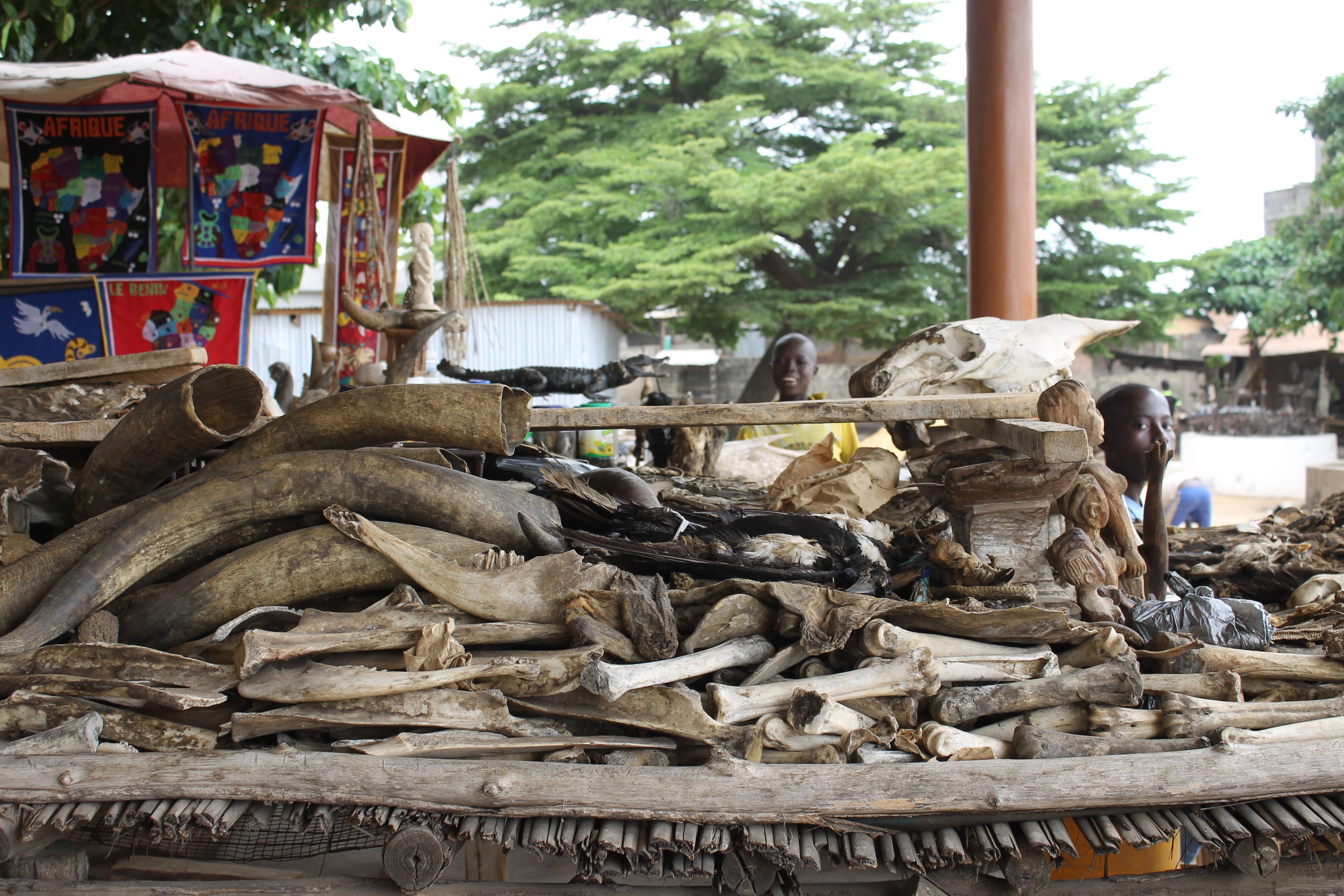 Animal bones and horns are stacked high at a stall at the Fetish Market. These items are usually ground up for use in powders, pastes, or other potions. (All photos: Angelica Calabrese)
Animal bones and horns are stacked high at a stall at the Fetish Market. These items are usually ground up for use in powders, pastes, or other potions. (All photos: Angelica Calabrese)
Got a big test coming up? Powdered chameleon will help you pass with flying colors. Training for a marathon? Rather than protein powder, try horse’s skull. Or, is unrequited love getting you down? A simple wayinoue, or love charm, should convince your future partner of your true worth.
Whatever your ailment is, the traditional healers at the Akodessewa Fetish Market in Lome, Togo have a solution. From buffalo skull to antelope horn, desiccated cobra to bear skin, the healers, or fetish priests, in West Africa’s largest “Marché des Fetiches” have a world of decaying animals at their fingertips, ready to be ground up, burned, imbibed, or whatever else the gods may decry.
Sitting under a shady tree in the center of an open plaza, Elias Guedenon, the son of one of the market’s fetish priests, describes Akodessewa as something of a pharmacy for practitioners of the voodoo religion.
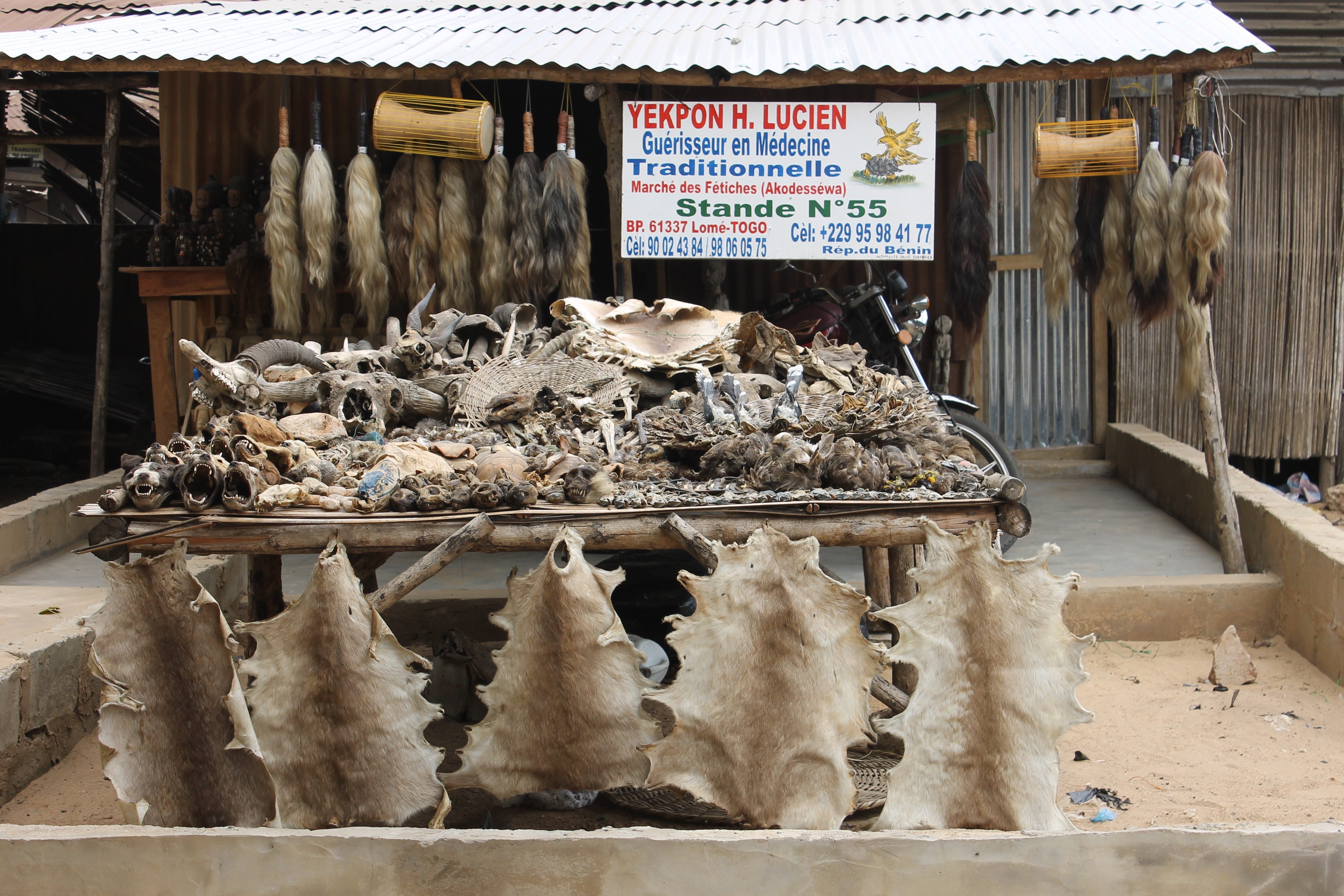 A fetish priest’s shack at the Akodessewa Fetish Market in Lome, Togo.
A fetish priest’s shack at the Akodessewa Fetish Market in Lome, Togo.
But this market has one striking difference from the others dotted across Togo and its eastern neighbor, Benin, where leopard heads and dog skulls and secret herbs can be purchased to cure everyday maladies. At the Fetish Market in Togo’s capital, voodoo practitioners and tourists alike can, with the help of a fetish priest, consult the gods directly to discuss whatever is ailing them.
Voodoo is an animist religion indigenous to West Africa that spread across the Atlantic to Haiti and Brazil with the slave trade. There are over 40 different gods, or fetiches, in the voodoo religion, and each god selects his feticheur, or fetish priest with whom he will communicate through dreams, broken shells, and other means. The conversations between the gods and the fetish priests take place in the priests’ hut or shacks, where they usually construct small statues to act as channels for communication.
In centuries past, customers would travel back and forth between consultations with the gods at the fetish priest’s home, and the market to purchase whatever objects the gods had deemed necessary. The Fetish Market, established in the Kingdom of Dahomey (present-day Benin) way back in 1863, streamlined the process by adding the religious mediation stations to a commercial area where remedies were sold.
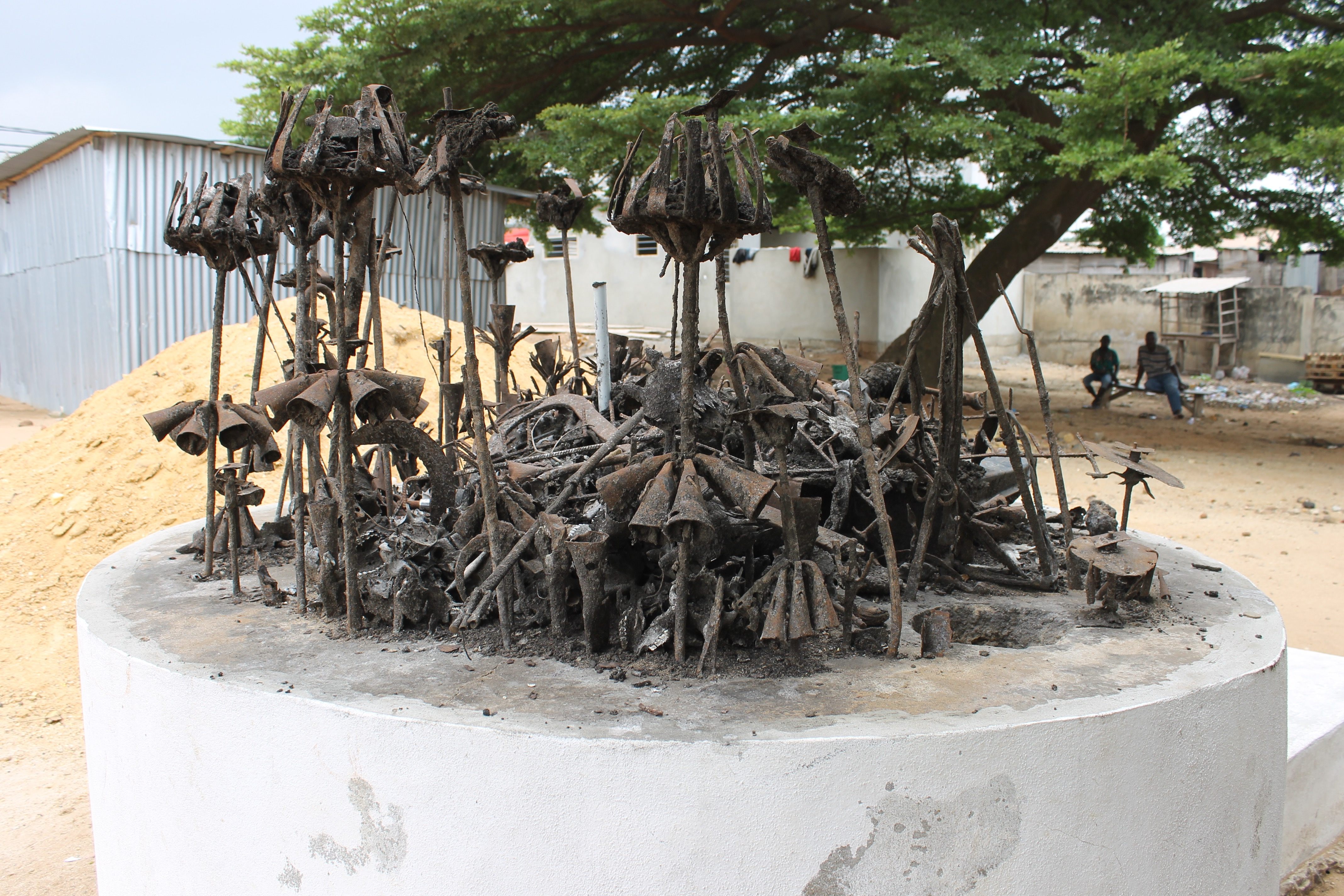 In the center of the Fetish Market, this iron sculpture houses the Vodun Gou, or Iron God, who protects the market.
In the center of the Fetish Market, this iron sculpture houses the Vodun Gou, or Iron God, who protects the market.
Today, the markets offers visitors a glimpse not only into the realities of the often misunderstood voodoo religion, but also into the ways that contemporary Togolese are synthesizing tradition and modernity, finding creative ways to attract business and tourism alike.
The easiest way to get there is on a zemidjan, or motorbike taxi. You’ll bounce down a potholed dirt road just outside of downtown Lomé until you reach a misspelled sign advertising the Marché des Fetiches. Inside, a few young boys and women stand beside tables piled with animal parts: warthog skulls, the scaled skin of an armadillo, legs of rabbits, limp squirrel tails and curved parrot beaks, the still-brightly-colored feathers of small tropical birds. A breeze stirs a pungent scent of decay through the air, but a few of the Togolese vendors still manage to eat lunch among the heads, scooping their pate with their fingertips as fat flies droop past.
Beside the shady tree in the center of the plaza where Guedenon collects the entrance fee for visitors who want a guided tour, is a blackened, spiky iron sculpture bedecked with the skulls of sacrificed goats: this is the channel for the protector god of the market, the Vodun Gou, or Iron God.
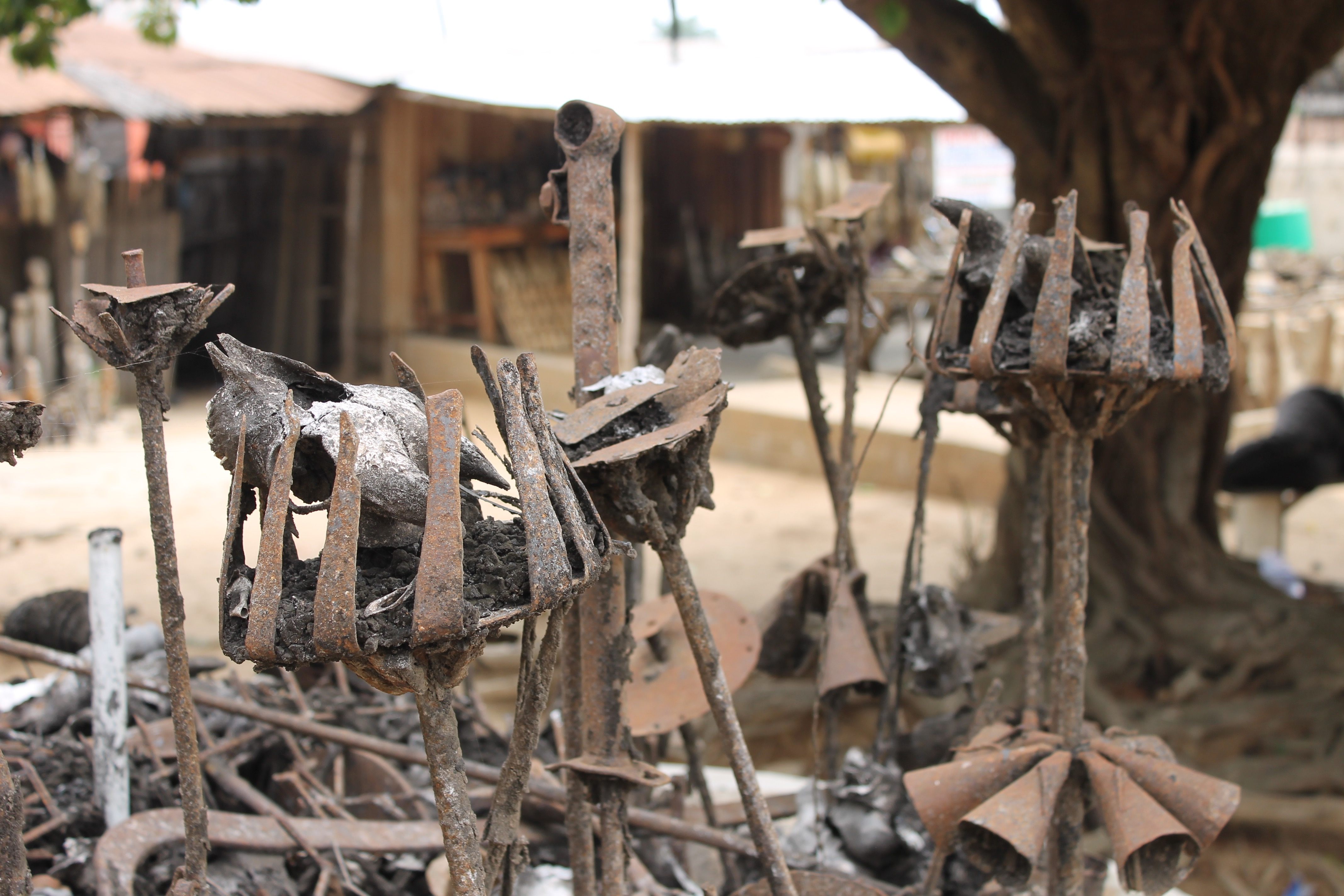 To satisfy the Vodun Gou, the priests routinely sacrifice goats and cows.
To satisfy the Vodun Gou, the priests routinely sacrifice goats and cows.
The fetish priests do their work by transforming everyday objects–from the tree at the entrance to the statues inside the fetish priests’ shacks–into channels through which they can communicate with the gods. The ability to communicate with the gods often runs in the family, Guedenon says. “You don’t become a fetish priest,” he emphasizes, “you are born a fetish priest.” When pregnant, the spouses of fetish priests consult with the gods to determine whether or not their child will also have the powers of communication.
Though his father was a fetish priest, Patience Dako was not chosen by the gods. But Dako, who now works as a guide at the Fetish Market, is nevertheless knowledgeable about the various protections and treatments that fetish priests offer. He pulls up his shirt to show us three small, black lines on his sternum, scars that mark the spot where his father made small cuts and rubbed them with a powder designed to protect him against evil and black magic.
The fetish priests at the market practice white magic, Dako explains, not black magic. Even though they use dead animal parts, their goal is always to help and to heal, not to hurt. Ebony seeds dried in a powder made of chameleon, monkey’s head, and secret herbs will improve your memory, he explains, and if you want to become a stronger and faster runner, he suggests a combination of secret herbs with the skulls of a horse and a deer and the heads of a dog and rabbit.
 Patience Dako’s father was a fetish priest, but he was not chosen by the gods for the profession. Today, he enthusiastically guides visitors through the market.
Patience Dako’s father was a fetish priest, but he was not chosen by the gods for the profession. Today, he enthusiastically guides visitors through the market.
The macabre objects sold in the Fetish Market’s traditional pharmacy come from a number of entrepreneurial individuals who collect and sell dead animal parts. “We have relationships with people from all over Africa,” Dako explains. But he stresses that the animals sold to the market cannot be killed for the purpose of their sale to the market. “The feticheursconsult the spirits to be sure that the animal was found rather than killed. If it was killed, it’s not accepted,” he explains.
The objects in the market range from everyday bats and goats and dogs sold by Togolese living nearby, to the foot-wide skin of an enormous boa constrictor from the jungles of Nigeria. But the market has an international audience that stretches far beyond West Africa: Dako tells us that objects arrive from Haiti and Brazil, as well as from West African expatriates living abroad in America and Europe. He pulls out a few ragged pieces of thick fur, far too thick for any animal living in a tropical area: a bear pelt. A Ghanaian living in Europe had used the pelt as decoration in his home; when it began to break down, he sold it to the Fetish Market rather than simply throwing it away.
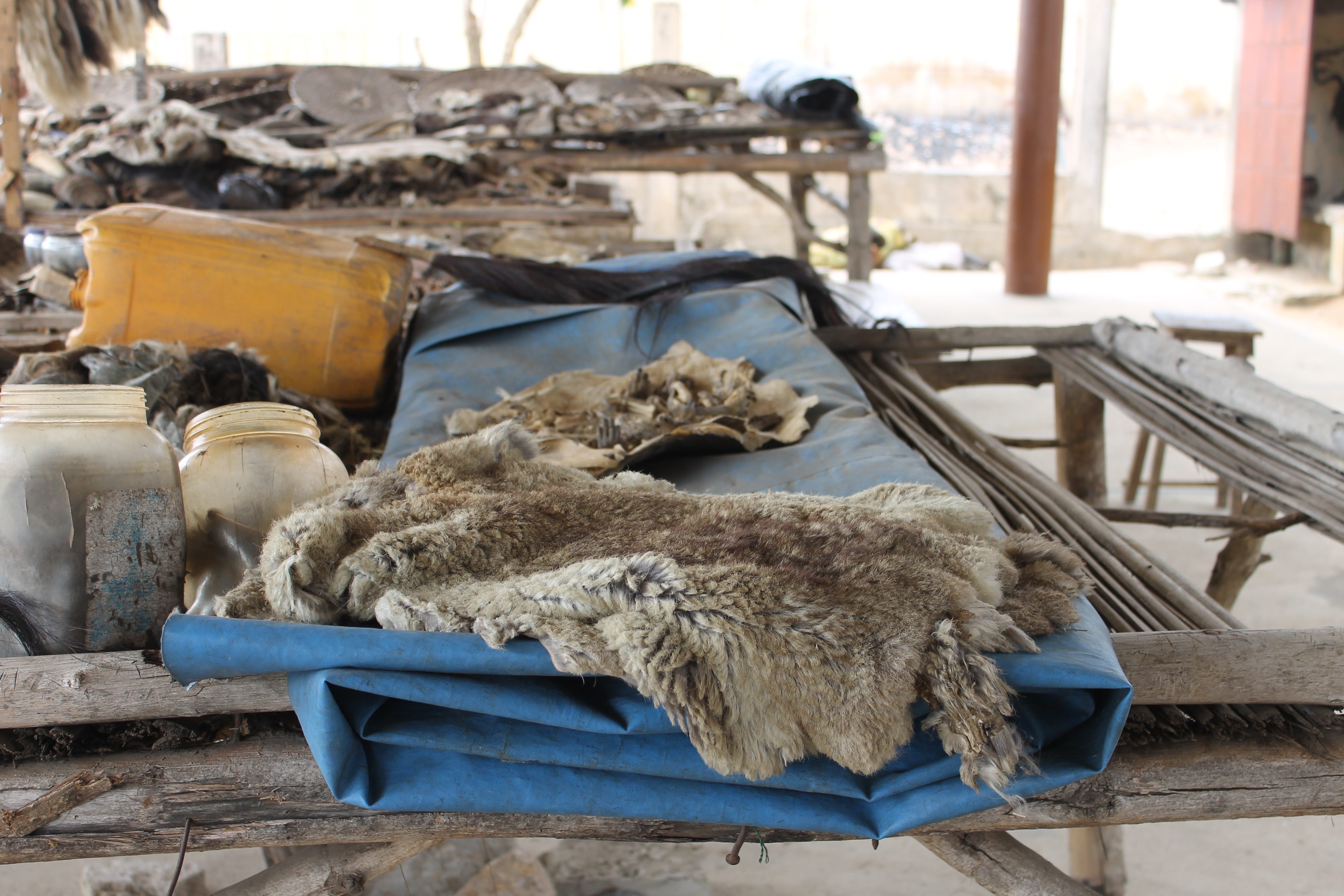 The bear pelt that was sold to the Fetish Market once it began to break down.
The bear pelt that was sold to the Fetish Market once it began to break down.
A few years ago, desperate patients might even be able to get their hands on an intact lion’s head, elephant’s foot, or hippopotamus skull at the Fetish Market – if they were willing to pay around $1,000 for it. But current governmental regulations have significantly curtailed the trade in parts of such protected animals, and they are rarely seen at the market today. But this doesn’t actually pose much of a problem, Guedenon explains. If lion’s head isn’t available, the head of less ferocious animal can be used. “It’s like Western medicine,” he says. “When you don’t find a specific product, you can use the generic version.”
Thanks to globalization, the market has changed significantly since it was first established 152 years ago, but it has always been a savvy operation. The original Beninese founders of the Marché des Fetiches were not only healers but also shrewd businessmen, and they soon realized that the market for fetish objects and traditional pharmacies was oversaturated in Benin. But in Togo, where the voodoo religion was also important, there were far fewer of such markets. In order to bring in more revenue, the Marché des Fetiches was moved from Dahomey to Lomé in the early years of the 20th century.
At first, the new market was set up in Lomé’s main market at Assigamé. But as the needs of the city grew, vendors began squeezing stalls full of food in between those piled high with dog paws and rotting birds. A clear health hazard, it was eventually relocated to its current location in Akodessewa. Today, the scent of rot and smoke that emanates from the market fills only the abandoned hallways of half-constructed cement buildings nearby.
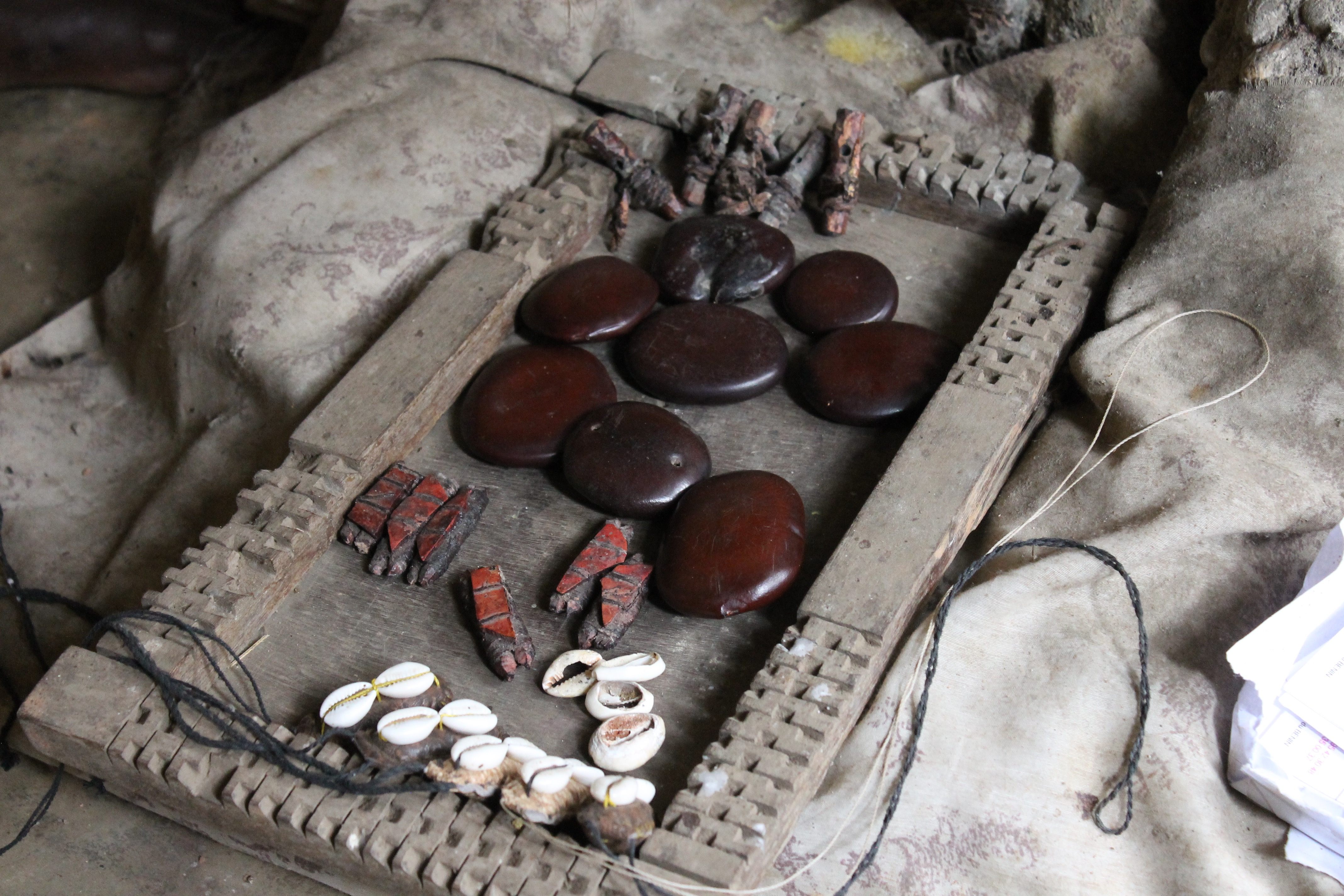 Inside of their shacks, fetish priests sell ebony wood seeds for good memory, good luck charms, and love amulets to tourists and Togolese practitioners.
Inside of their shacks, fetish priests sell ebony wood seeds for good memory, good luck charms, and love amulets to tourists and Togolese practitioners.
But in spite of its dismal surroundings, the site continues to attract tourists from all over the world. For the equivalent of about $10 U.S. dollars, tourists can visit the market with a knowledgeable guide and take photos, and for an additional fee (one negotiated with the gods) they can even purchase fetish charms, and have their ailments diagnosed and treated by an experienced feticheur like Thomas Zonnontin.
Zonnontin presents visitors with his business card upon entrance into his corrugated tin shack, advertising his services as an “herbal healer in traditional medicine.” A framed, monogrammed, and color-printed certificate hanging on the tin and reed wall asserts his qualifications in traditional medicine. But in the center of the floor of the small shack is his legba, or the statue through which he communicates with the gods: two roughly hewn stone faces with curved, protruding noses, and cowry-shaped eyes covered in drippings of wax and animal parts.
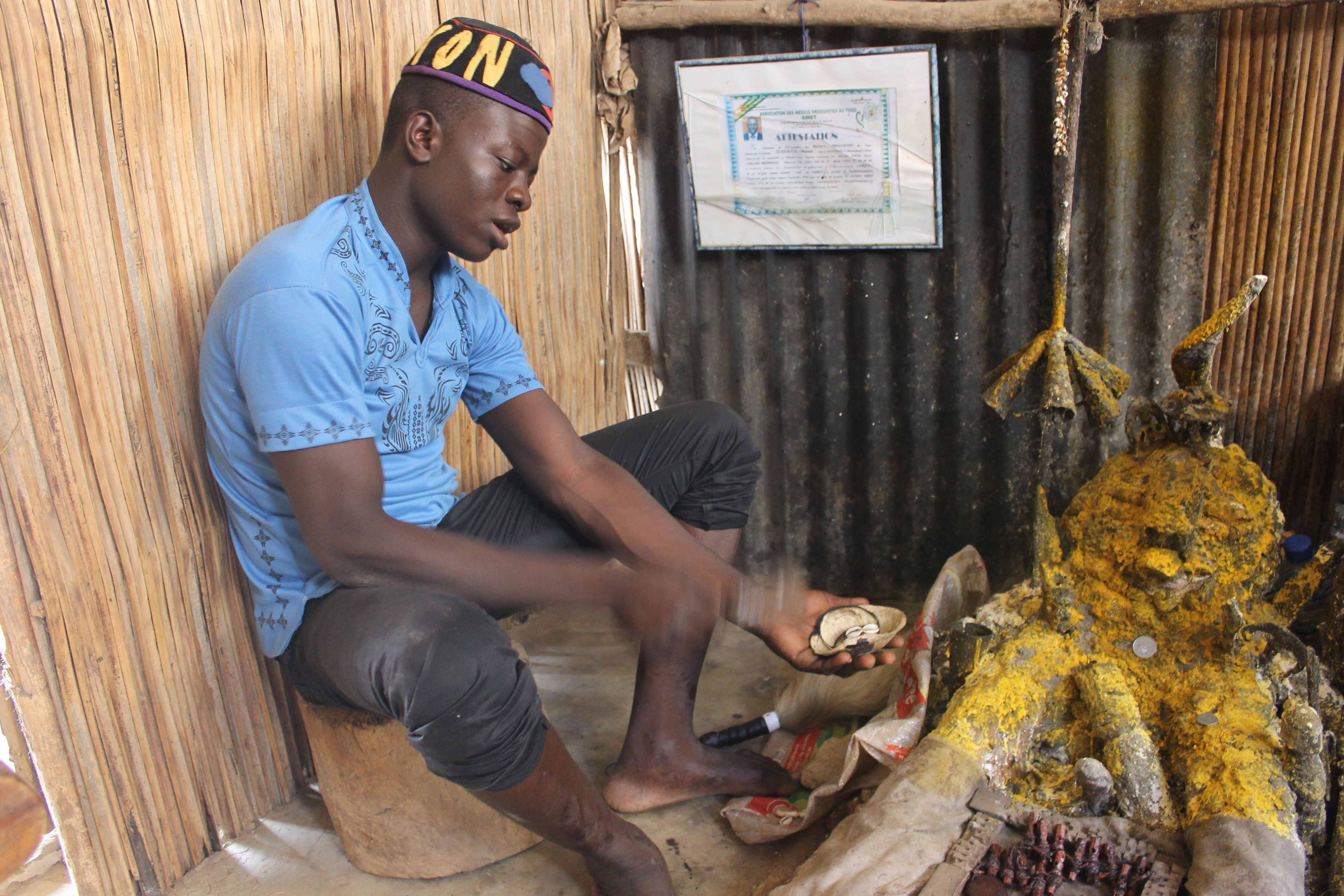 Thomas Zannontin’s son blesses a good luck charm, while his father’s certificate in herbal medicine hangs on the wall behind him.
Thomas Zannontin’s son blesses a good luck charm, while his father’s certificate in herbal medicine hangs on the wall behind him.
A visit works like this: A fetish priest like Zonnnontin markets his good-luck charms and fetish objects, and the visitor selects what he or she is interested in purchasing by placing each object in a tortoise shell before the legba. Each object is blessed with an incantation, and then Zonnontin begins the price-negotiation process by tossing and re-tossing a collection of broken cowry shells on the dirt floor. When a price is agreed upon and the purchases are made, he bids his visitors a warm goodbye, and insists that they be in touch to tell him how the charms and remedies are working. Zonnontin points out not only his phone number, but also his email address on the business card–you can contact him from wherever in the world you might be.
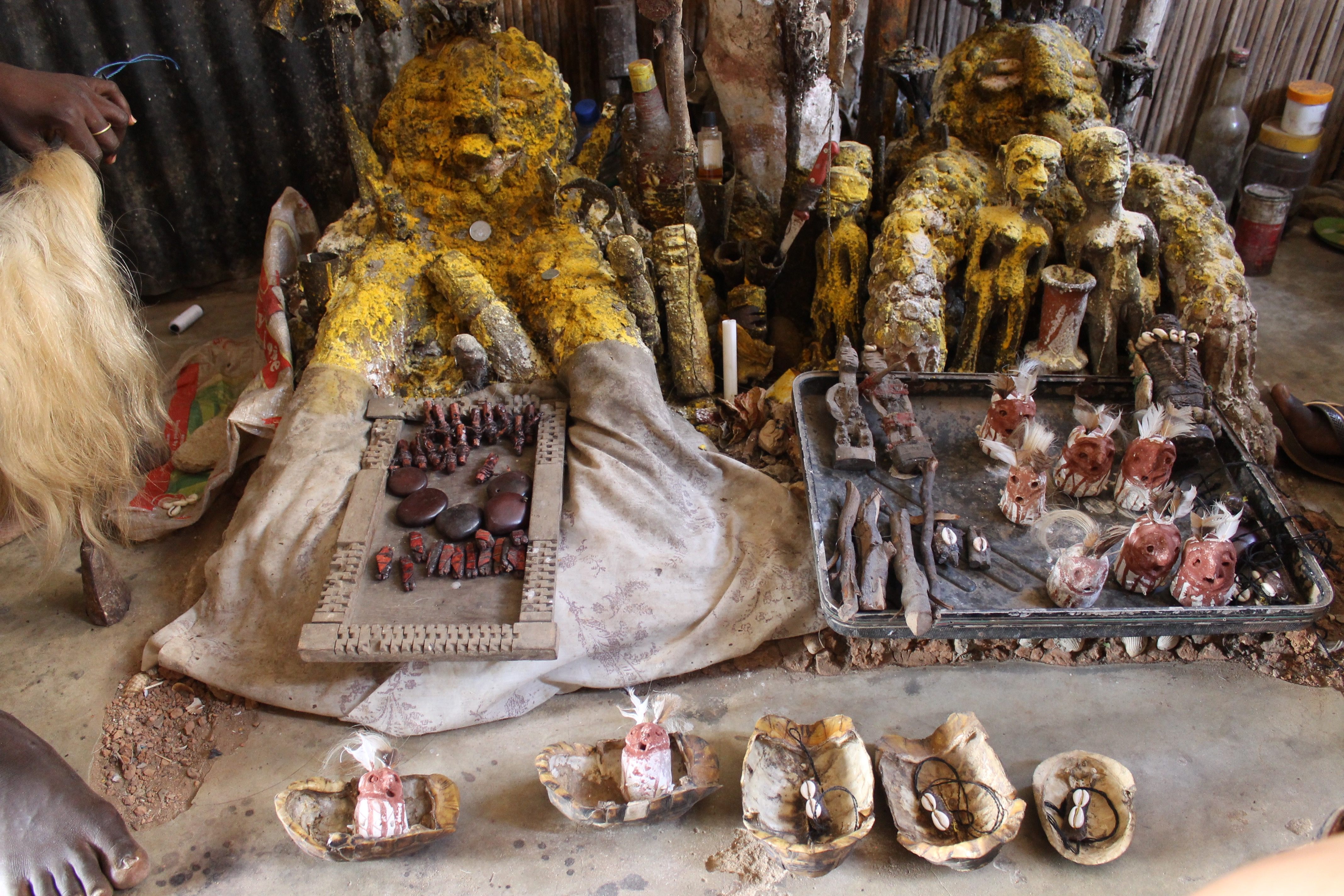 Good luck charms are placed in tortoise shells in front of the two “legba” in Thomas Zannontin’s hut
Good luck charms are placed in tortoise shells in front of the two “legba” in Thomas Zannontin’s hut
The fetish priests have kept the Marché des Fetiches in operation for over 150 years, fielding relocations and a dwindling trade in animal parts, and responding to the contemporary demand for certifications, qualifications, and even email addresses. Today, gaggles of tourists taking photos mix with Togolese customers carrying plastic bags overflowing with purchases out of the market on the back of motorbikes.
If you can make the trip, stand the stench, and suspend your disbelief for a few hours, perhaps someday you might end up becoming a faster runner, throwing away your datebook because your memory has gotten so good, or convincing a dubious lover of your true worth.










Follow us on Twitter to get the latest on the world's hidden wonders.
Like us on Facebook to get the latest on the world's hidden wonders.
Follow us on Twitter Like us on Facebook